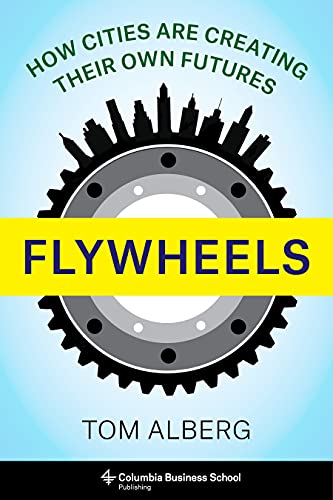Flywheels
How Cities Are Creating Their Own Futures
Tom Alberg
BOOK REVIEW

Urban landscapes are not merely the backdrop of our daily lives; they are dynamic ecosystems waiting to be harnessed. In Flywheels: How Cities Are Creating Their Own Futures, Tom Alberg invites us to peer into this bustling arena where innovation meets urban planning and the future is mapped out by the very cities we inhabit. This is a powerful exploration of how cities can transform themselves into engines of growth, resilience, and sustainability-ultimately influencing the entire world.
Diving deep into the principles of urban development, Alberg unveils the intricate mechanisms that allow cities to thrive, transforming challenges into opportunities. At the heart of his thesis lies the concept of "flywheels"-a metaphor that illustrates how certain positive forces, once set in motion, can accelerate growth exponentially. The author pulls from a myriad of case studies, showcasing cities that have successfully implemented strategies to propel themselves forward. These are not just stories; they resonate with the raw pulse of transformation that each city can experience.
What makes Alberg's argument so compelling isn't merely his data-driven analysis; it's the emotion that he manages to weave through his narrative. Each city discussed becomes a character in its own right-each grappling with issues such as technological advancement, social equity, and environmental sustainability. The stories of cities like Seattle and Austin become more than just geographical details; they represent hope and potential. As you turn each page, you can almost feel the excitement of urban planners and citizens alike, brimming with ideas that could reshape their communities.
Readers from diverse backgrounds have not only garnered insights from Alberg's work but also sparked passionate discussions about the future of urban environments. Some express sheer admiration for the way he tackles complex concepts in an engaging, accessible manner. One reader remarked, "Alberg's vision for cities gives me hope as we navigate the uncertainties of our changing world." Meanwhile, others challenge his views, arguing that not all cities have the same resources or governmental structures to implement these 'flywheels.' This spectrum of opinions enhances the reading experience, demanding active engagement and thoughtful consideration from every individual.
The historical context surrounding urban development is crucial, and Alberg delves into it with finesse. The impact of globalization, technological evolution, and even historical events-like the recent pandemic-reverberate through his explorations. He demonstrates how cities were forced to adapt during crises, emerging not just as survivors but as innovators. His approach compels the reader to rethink what a city can represent, pushing the boundaries of traditional urbanism.
This is not just a technical manual; Alberg's writing transcends that label. It is a call to action-a passionate plea for all of us to become stakeholders in the futures of our urban spaces. The book resonates with anyone who has ever yearned for change in their community, urging us to envision possibilities beyond what we see. You cannot help but feel a sense of urgency and responsibility to contribute to this new paradigm.
Let's not forget the artistic metaphors scattered throughout the narrative, sharpening the emotional connection to his arguments. Alberg's prose invites you to witness cities as living entities, pulsing with activity, human connections, and organic growth. The way he illustrates urban challenges feels like witnessing a drama unfold-each obstacle is a thrilling confrontation, each success a moment of jubilation worthy of celebration.
As you close the final chapter, a lingering feeling remains: the notion that cities, with all their flaws, can indeed chart their own destinies. Alberg masterfully leaves the reader wrestling with ideas, filled with a contagious enthusiasm for what lies ahead. It's an invitation to not just imagine our future cities but to actively participate in their creation.
Flywheels: How Cities Are Creating Their Own Futures is a manifesto for the urban dreamers, the planners, and every citizen who is ready to step into the arena. It dares you to challenge your perceptions and get involved in reshaping the fabric of your community. Don't let these insights slip through your fingers-this work is essential for anyone who believes in the power of cities to drive the future forward. 🌍✨️
📖 Flywheels: How Cities Are Creating Their Own Futures
✍ by Tom Alberg
🧾 298 pages
2021
#flywheels #cities #creating #their #futures #alberg #TomAlberg